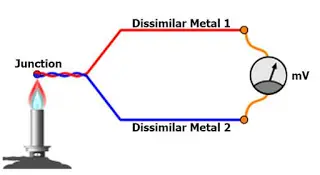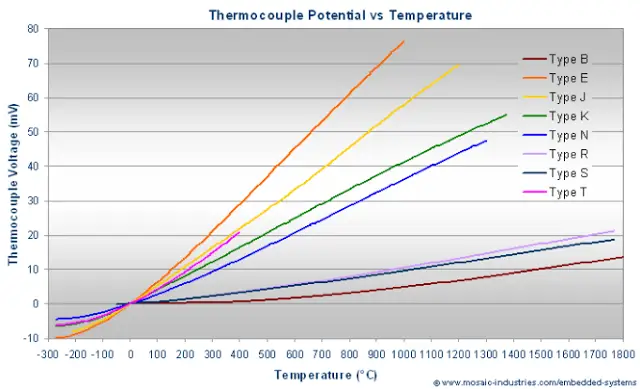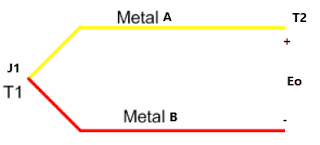 |
| Fig. Thermocouple (source: sterlingsensors.co.uk) |
Contents
show
What is a Thermocouple?
A thermocouple consists of a pair of dissimilar wires joined at one end. It is an active transducer. On the other hand, RTD and thermistors are passive transducers. Thermocouple work on the principle of Seebeck effect.
According to Seebeck effect, if two dissimilar metals are joined together and the resulting two junctions thus formed are placed at different temperatures then a current flow through the loop as shown in the figure below.
If this loop is cut in between, an emf appears at the end, known as Seebeck emf. This phenomenon is known as thermoelectric effect. It is shown in the figure below.
The Seebeck emf, Eo at the output is proportional to the temperature difference between the two junctions (J1 & J2) i.e.
Eo = ⍺ (T1 − T2)
where ⍺ is Seebeck coefficient
T1 & T2 are the temperatures of junction J1 & J2 respectively.
Hence, by measuring Eo as shown in the figure below. temperature T1 can be calculated. T2 temperature is known to us.
Types of thermocouples
Various combination of material is used in industries and accordingly named as Type B, Type E, Type J, Type K, Type N, Type R, Type S, and Type T. The various types of thermocouples with their range and corresponding outputs are given below.
 |
| source: mosaic-industries.com/embedded-systems |
The comparison between different types of the thermocouple is given below in table 1.
 |
| source: embedded.com/print/4368765 |
In order to meet high voltage requirements (since outputs of thermocouples are low), a number of thermocouples are connected in series as shown in the figure below.
 |
| Fig. Series connected thermocouples (source: Wikipedia) |
Similarly, when high current is required, a number of thermocouples are connected in parallel as shown in the figure below.
 |
| Fig. Parallel connected thermocouples (source: allaboutcircuits.com) |
These groups of thermocouples (series or parallel connected) are called as thermopiles.
Advantages of thermocouples
1. They are rugged devices.
2. They are cheaper than the RTD.
3. They work for wide range of temperature i.e. -270 °C to 2700 °C.
4. They work even for long distance transmission.
5. There is no need for any bridge circuit for measurement.
6. They are suitable for recording rapid ranges in temperature because thermocouples follow the temperature changes with a small time lag. Hence, Good speed response.
7. Reproducibility
8. Useful for the measurement of particular point temperature.
Disadvantages of thermocouples
1. Lower accuracy.
2. Non-linear characteristics.
3. Cold junction/isothermal block compensation is necessary.
4. There is stray voltage pickup while a measurement.
5. Signals need to be amplified since thermocouples output is in the millivolt range.
Exercise
Q. What are thermowells?
Ans. Stainless steel wells or tubes that used to protect the thermocouples from mechanical damage and the corrosive environment is called as thermowell.
Q. How the thermocouple output is measured?
Ans. Thermocouple output can be measured using Permanent Magnet Moving Coil (PMMC) voltmeter of millivolt range. Another method to measure output is using d.c. potentiometer. In some cases, there is need of amplifying the thermocouple to accurately measure voltage using PMMC voltmeter or d.c. potentiometer.
Q. What are the applications of thermocouples?
Q. Why a compensation circuit is needed in thermocouple measurement?
Q. What are the different types of compensation used in thermocouple measurement?
Q. Why and How the software compensation is done in thermocouple measurement?




Awesome Article Sir, Easy and Concise explanations really appreciated the author efforts, Hope to learn more from here.